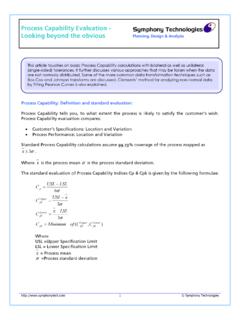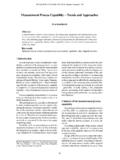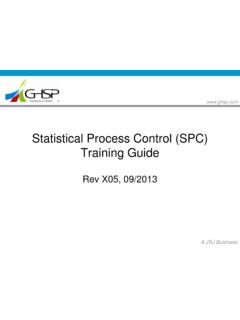Transcription of Measuring Your Process Capability - Software for …
1 Measuring Your Process Capability Planning, Design & Analysis 1 Symphony Technologies Preamble: This article is devoted to the topic of Process Capability , with the objective of making people aware of this subject and its significance to business success. The author believes that personal awareness is a prerequisite to personal action, and personal action is what we need for success. It can be a source material for you to use in discussing this topic with your organization. It will address issues like what is Process Capability , how to measure it, and how to calculate the Process Capability indices (Cp, Cpk).
2 It will also attempt to explain the differences between Process Capability and Process performance; relationship between Cpk and non-conforming (defect) rate; and illustrate the four outcomes of comparing natural Process variability with customer specifications. Lastly a commentary is provided on precautions we should take while conducting Process Capability studies. What is Process Capability ? 1. Process Capability is the long-term performance level of the Process after it has been brought under statistical control. In other words, Process Capability is the range over which the natural variation of the Process occurs as determined by the system of common causes.
3 2. Process Capability is also the ability of the combination of people, machine, methods, material, and measurements to produce a product that will consistently meet the design requirements or customer expectation. What is a Process Capability Study? Process Capability study is a scientific and a systematic procedure that uses control charts to detect and eliminate the unnatural causes of variation until a state of statistical control is reached. When the study is completed, you will identify the natural variability of the Process . Process Capability is the long-term performance level of the Process after it has been brought under statistical control.
4 It is the ability of the combination of your 5 M's to produce a product that will consistently meet the design requirements and the customer expectation. In this article, Dr. Nosh Kapadia explains: How to calculate Cp, Cpk, Cpl and Cpu indices, Why should You know the Capability of Your and your supplier's Processes, The difference between Capability indices and Process performance indices, The relation between Process Capability and defect rate and Some assumptions and precautions while calculating Process Capability indices. Measuring Your Process Capability Planning, Design & Analysis 2 Symphony Technologies Why Should I know the Capability of My Processes?
5 Process Capability measurements allow us to summarize Process Capability in terms of meaningful percentages and metrics. To predict the extent to which the Process will be able to hold tolerance or customer requirements. Based on the law of probability, you can compute how often the Process will meet the specification or the expectation of your customer. You may learn that bringing your Process under statistical control requires fundamental changes - even redesigning and implementing a new Process that eliminates the sources of variability now at work.
6 It helps you choose from among competing processes, the most appropriate one for meeting customers' expectation. Knowing the Capability of your processes, you can specify better the quality performance requirements for new machines, parts and processes. Why Should I know the Capability of My Supplier's Processes ? 1. To set realistic cost effective part specifications based upon the customer's needs and the costs associated by the supplier at meeting those needs. 2. To understand hidden supplier costs. Suppliers may not know or hide their natural Capability limits in an effort to keep business.
7 This could mean that unnecessary costs could occur such as sorting to actually meet customer needs. 3. To be pro-active. For example, a Cpk estimation made using injection molding pressure measurements during a molding cycle may help reveal a faulty piston pressure valve ready to malfunction before the actual molded part measurements go out of specifications. Thus saving time and money. Measures of Process Capability - Process Capability Indices: Cp, Cpl, Cpu, and Cpk are the four most common and timed tested measures of Process Capability . Process Capability indices measure the degree to which your Process produces output that meets the customer's specification.
8 Process Capability indices can be used effectively to summarize Process Capability information in a convenient unitless system. Cp and Cpk are quantitative expressions that personify the variability of your Process (its natural limits) relative to its specification limits (customer requirements). Measuring Your Process Capability Planning, Design & Analysis 3 Symphony Technologies Following are the graphical details and equations quantifying Process Capability : Where : USL = Upper Specification Limit LSL = Lower Specification Limit X-Bar = Mean of the Process s = Standard Deviation of the Process INDEX ESTIMATED EQUATION USAGE Cp (USL - LSL) / 6s Process Capability for two - sided specification limit, irrespective of Process center.
9 Cpu (USL - X-Bar) / 3s Process Capability relative to upper specification limit. Cpl (X-Bar - LSL) / 3s Process Capability relative to lower specification limit. Cpk Min. of (Cpu , Cpl ) or Distance between mean of the Process and the closest spec. limit / of the Process variability. Process Capability for two - sided specification limit accounting for Process centering. Notes : 1. If X-Bar is at target, then Cp = Cpk. 2. Cpk will always be equal to or less than Cp. The Cpk, Ppk Quandary : In 1991, ASQ / AIAG task force published the "Statistical Process Control" reference manual, which presented the calculations for Capability indices ( Cp, Cpk ) as well as Process performance indices ( Pp, Ppk ).
10 Measuring Your Process Capability Planning, Design & Analysis 4 Symphony Technologies The difference between the two indices is the way the Process standard deviation ( s ) is calculated. Cpk uses s which is estimated using ( R-Bar / d2 ) or ( S-Bar / C2 ) . Ppk uses the calculated standard deviation from individual data where s is calculated by the formula : So the next question is which metric is best to report Cpk or Ppk? In other words, which standard deviation to use - estimated or calculated? Although both indices show similar information, they have slightly different uses.












